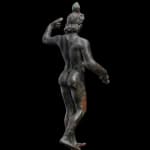Hellenistic
Further images
Provenance
Sasson family collection, Jerusalem, Israel, acquired before 2000Literature
The surviving Alexander Doryphoros types, attributed to Lysippos, assert an image of a king whose authority over his ‘spear-won’ land is a gift from the gods. The heroic nudity and the spear may be seen to promote a connection to mythological heroes such as Achilles and the Dioskouroi, and to Zeus himself, who is often depicted with a spear.
Alexander is shown in a relaxed yet mobile posture, spear-bearing, sometimes holding a sword ( a parazonium, as in this example), heroic muscular nudity, lightly curling hair, the head tilted. According to Andrew Stewart, such statues ‘simultaneously flaunted the source of his power (his physical and martial prowess) and served as icons of his personal dominion over Asia [.....]. By successfully manipulating Greek society’s central symbolic form, these portraits transformed the nude, youthful, heroic victor of surpassing arete into the charismatic young king of Asia’: A. Stewart, Faces of Power, Alexander’s Image and Hellenistic Politics, Berkeley, 1993, p. 167.
This bronze must be seen in the light of this iconography. According closely with the various surviving types of Alexander Doryphoros bronzes, the subject may certainly be seen as Alexander. The bronze bears features of both the Stanford and Fouquet types of the Alexander Doryphoros: the sheathed sword with hilt forward can be seen in the Stanford Type (acc. no. 1975.47), with the posture and total nudity paralleled in the Fouquet (Louvre, Br 370.)
Surviving Alexander Doryphoros types can further vary through the addition of specific attributes to show Alexander in the guise of a particular deity, or to make a more focussed political statement. As in this example, where an unusual oval shaped attribute on his head may perhaps be derived from another hitherto unknown sculptural type, there are also bronzes where he wears a Phrygian cap indicating his Macedonian background, a crown of rays as Alexander-Helios, or an egg-like cap as Alexander-Dioskouros, where Alexander is presented in the guise of a son of Zeus (see A. Hermary, “Dioskouri,” LIMC, vol. III, no. 92). Alexander pronounced himself the son of Zeus, quite literally a ‘Dioskouros’ and the iconography of the Dioskouroi by the Hellenistic period became closely interlinked with that of Alexander, with the twins often depicted holding a spear each, and sometimes even with an upturned sword as is so distinctive of the Alexander Doryphoros.
The image of Alexander through his program of portrait sculpture, conveys a multitude of messages but the Alexander Doryphoros encapsulates his assertion of martial arete, his god-given personal power and victory; it is a potent symbol of a conqueror, of his dominion, in an unequivocal visual language entirely understood by the ancient Greek viewer. For further discussion, see A. Stewart, Faces of Power, Alexander’s Image and Hellenistic Politics, Berkeley, 1993.





